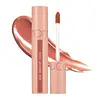What's inside
What's inside
 Key Ingredients
Key Ingredients

 Benefits
Benefits

 Concerns
Concerns

 Ingredients Side-by-side
Ingredients Side-by-side

Water
Skin ConditioningOctyldodecanol
EmollientDimethicone
EmollientAlcohol Denat.
AntimicrobialAcrylates Copolymer
Polysorbate 60
EmulsifyingEthylcellulose
Behenyl Alcohol
EmollientPentylene Glycol
Skin ConditioningSodium Acrylate/Sodium Acryloyldimethyl Taurate Copolymer
Emulsion StabilisingSilica
AbrasiveSorbitan Stearate
EmulsifyingIsohexadecane
EmollientDiisostearyl Malate
EmollientPhenoxyethanol
PreservativeCI 77891
Cosmetic ColorantPolyglyceryl-2 Triisostearate
EmulsifyingPolysorbate 80
EmulsifyingCI 77491
Cosmetic ColorantCI 77492
Cosmetic ColorantParfum
MaskingCI 77499
Cosmetic ColorantSorbitan Oleate
EmulsifyingAroma
Trisodium Ethylenediamine Disuccinate
Ethylhexylglycerin
Skin ConditioningCI 15850
Cosmetic ColorantPolyglyceryl-2 Diisostearate
EmulsifyingCI 17200
Cosmetic ColorantCI 15985
Cosmetic ColorantCI 42090
Cosmetic ColorantButylene Glycol
HumectantActinidia Chinensis Fruit Extract
EmollientCarica Papaya Fruit Extract
Skin ConditioningCitrus Paradisi Fruit Extract
Skin ConditioningCocos Nucifera Fruit Extract
EmollientMangifera Indica Fruit Extract
Skin ConditioningPsidium Guajava Fruit Extract
AstringentWater, Octyldodecanol, Dimethicone, Alcohol Denat., Acrylates Copolymer, Polysorbate 60, Ethylcellulose, Behenyl Alcohol, Pentylene Glycol, Sodium Acrylate/Sodium Acryloyldimethyl Taurate Copolymer, Silica, Sorbitan Stearate, Isohexadecane, Diisostearyl Malate, Phenoxyethanol, CI 77891, Polyglyceryl-2 Triisostearate, Polysorbate 80, CI 77491, CI 77492, Parfum, CI 77499, Sorbitan Oleate, Aroma, Trisodium Ethylenediamine Disuccinate, Ethylhexylglycerin, CI 15850, Polyglyceryl-2 Diisostearate, CI 17200, CI 15985, CI 42090, Butylene Glycol, Actinidia Chinensis Fruit Extract, Carica Papaya Fruit Extract, Citrus Paradisi Fruit Extract, Cocos Nucifera Fruit Extract, Mangifera Indica Fruit Extract, Psidium Guajava Fruit Extract
Triisostearyl Citrate
EmollientHydrogenated Polyisobutene
EmollientButyrospermum Parkii Butter
Skin ConditioningMicrocrystalline Wax
Emulsion StabilisingPunica Granatum Sterols
Skin ConditioningOctyldodecanol
EmollientPolyethylene
AbrasiveDisteardimonium Hectorite
StabilisingRicinus Communis Seed Oil
MaskingCocos Nucifera Oil
MaskingAloe Barbadensis Leaf Extract
EmollientPersea Gratissima Oil
Skin ConditioningPhytosterols
Skin ConditioningLinolenic Acid
CleansingLinoleic Acid
CleansingHydrogenated Castor Oil
EmollientLauryl PCA
HumectantSodium Hyaluronate
HumectantCaprylyl Glycol
EmollientOleic Acid
EmollientLecithin
EmollientHexylene Glycol
EmulsifyingPhenoxyethanol
PreservativeTetrahexyldecyl Ascorbate
AntioxidantTocopheryl Acetate
AntioxidantMica
Cosmetic ColorantCI 77891
Cosmetic ColorantCI 77491
Cosmetic ColorantCI 77492
Cosmetic ColorantCI 77499
Cosmetic ColorantCI 77163
Cosmetic ColorantCI 42090
Cosmetic ColorantCI 75470
Cosmetic ColorantCI 15850
Cosmetic ColorantCI 45380
Cosmetic ColorantCI 45410
Cosmetic ColorantCI 73360
Cosmetic ColorantCI 17200
Cosmetic ColorantCI 19140
Cosmetic ColorantCI 15985
Cosmetic ColorantTriisostearyl Citrate, Hydrogenated Polyisobutene, Butyrospermum Parkii Butter, Microcrystalline Wax, Punica Granatum Sterols, Octyldodecanol, Polyethylene, Disteardimonium Hectorite, Ricinus Communis Seed Oil, Cocos Nucifera Oil, Aloe Barbadensis Leaf Extract, Persea Gratissima Oil, Phytosterols, Linolenic Acid, Linoleic Acid, Hydrogenated Castor Oil, Lauryl PCA, Sodium Hyaluronate, Caprylyl Glycol, Oleic Acid, Lecithin, Hexylene Glycol, Phenoxyethanol, Tetrahexyldecyl Ascorbate, Tocopheryl Acetate, Mica, CI 77891, CI 77491, CI 77492, CI 77499, CI 77163, CI 42090, CI 75470, CI 15850, CI 45380, CI 45410, CI 73360, CI 17200, CI 19140, CI 15985
 Reviews
Reviews

Ingredients Explained
These ingredients are found in both products.
Ingredients higher up in an ingredient list are typically present in a larger amount.
Ci 15850 is the pigment color red. It is an azo dye and created synthetically.
Azo dyes need to be thoroughly purified before use. This allows them to be more stable and longer-lasting.
This ingredient is common in foundations, lipsticks, and blushes. This color is described as brown/orangey red.
It has many secondary names such as Red 6 and Red 7. According to a manufacturer, Red 6 usually contains aluminum.
Learn more about CI 15850Ci 15985 is a dye made from petroleum. It is synthetically created and approved by the FDA for use in foods and cosmetics.
The color of this dye is orange/yellow.
This ingredient can be found in makeup, sun care, and skincare.
Learn more about CI 15985Ci 17200 is a synthetic reddish-purple dye.
Ci 42090 is a synthetic dye created from petroleum. It is used to give a bright blue color to cosmetics, medicine, and food.
Ci 77491 is also hydrated iron III oxide. It's sole purpose is to give a red/pink hue to products.
Iron III oxides are classified as inorganic chemicals for coloring.
Synthetically created Ci 77491 is considered safer than those naturally found. This is because the synthetically created version may contain less impurities. Iron oxides are generally non-toxic and non-allergenic.
Learn more about CI 77491Ci 77492 is also hydrated iron III oxide. It's sole purpose is to give a yellow hue to products.
Iron III oxides are classified as inorganic chemicals for coloring.
Synthetically created Ci 77492 is considered safer than those naturally found. This is because the synthetically created version may contain less impurities. Iron oxides are generally non-toxic and non-allergenic.
Learn more about CI 77492Ci 77499 is also hydrated iron III oxide. It is created from mixing red and black iron oxides. This helps give shades of darkness to a product.
Iron III oxides are classified as inorganic chemicals for coloring.
Ci 77891 is a white pigment from Titanium dioxide. It is naturally found in minerals such as rutile and ilmenite.
It's main function is to add a white color to cosmetics. It can also be mixed with other colors to create different shades.
Ci 77891 is commonly found in sunscreens due to its ability to block UV rays.
Learn more about CI 77891Octyldodecanol is a fatty alcohol. It is primarily used to enhance the texture of products.
As an emulsifier, Octyldodecanol helps prevent the oils and waters from separating. It also prevents ingredients from creating foam when shaken.
Octyldodecanol is created by reducing fatty acid to an alcohol.
Due to its high molecular weight, it does not get absorbed into the skin.
Learn more about OctyldodecanolPhenoxyethanol is a preservative that has germicide, antimicrobial, and aromatic properties. Studies show that phenoxyethanol can prevent microbial growth. By itself, it has a scent that is similar to that of a rose.
It's often used in formulations along with Caprylyl Glycol to preserve the shelf life of products.